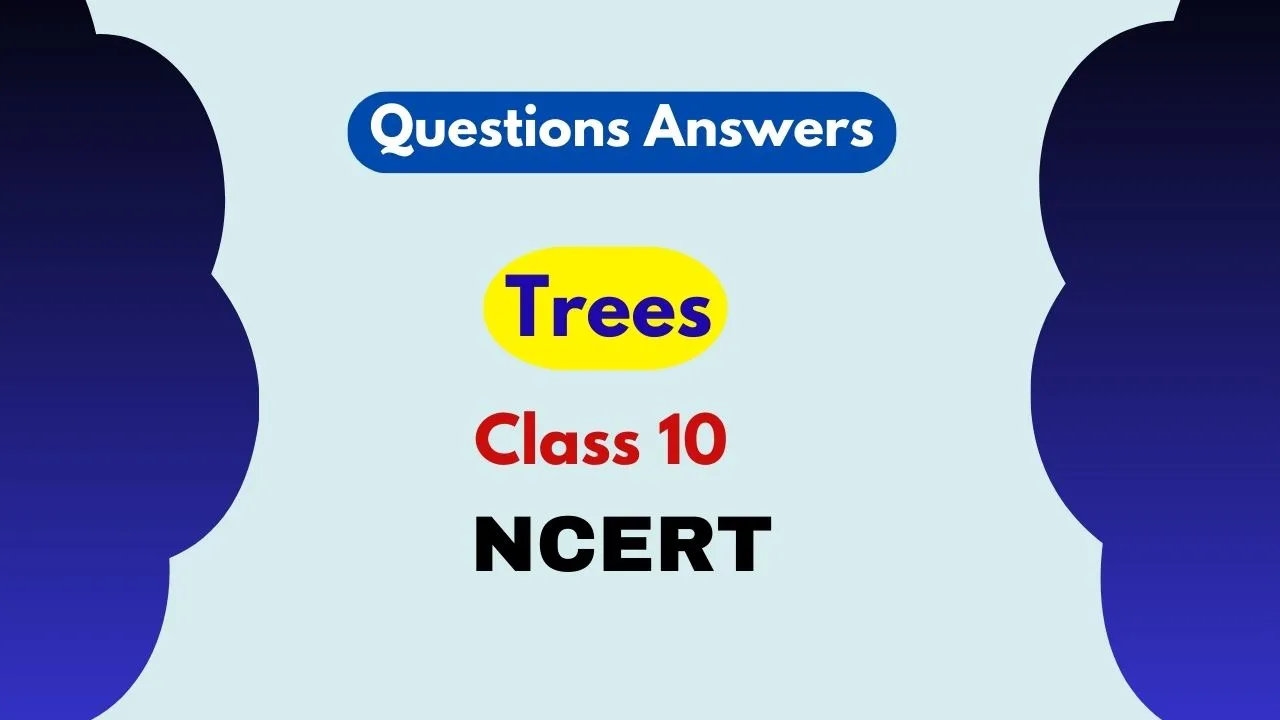Trees Class 10 Questions Answers have been provided here for class 10 students of CBSE Board with a variety of questions prescribed by NCERT. These Trees Class 10 Questions Answers will be very effective for class 10 students in the 2024 of CBSE Board Exam.
Summary of the poem, Trees Class 10
In “Trees,” Adrienne Rich illustrates the cyclical nature of trees shedding leaves as a metaphor for personal rejuvenation. Beyond the natural cycle, the poem symbolizes liberation from societal constraints. Rich urges individuals, particularly women, to break free from societal norms and constraints, advocating for empowerment through shedding the old and embracing change. The poem resonates with the idea of resilience, emphasizing the importance of personal growth and finding strength in embracing transformation.
Translation
“ट्रीज़” में, एड्रिएन रिच व्यक्तिगत कायाकल्प के रूपक के रूप में पेड़ों की पत्तियों को गिराने की चक्रीय प्रकृति को चित्रित करता है। प्राकृतिक चक्र से परे, कविता सामाजिक बाधाओं से मुक्ति का प्रतीक है। रिच व्यक्तियों, विशेष रूप से महिलाओं से, सामाजिक मानदंडों और बाधाओं से मुक्त होने का आग्रह करते हैं, पुरानी बातों को त्यागने और परिवर्तन को अपनाने के माध्यम से सशक्तिकरण की वकालत करते हैं। कविता लचीलेपन के विचार से गूंजती है, व्यक्तिगत विकास के महत्व पर जोर देती है और परिवर्तन को अपनाने में ताकत ढूंढती है।
CBSE Class 10 English (Literature and Language) Questions Answers pdf 2024
Suggestive Sample Question Answers Papers pdf 2024 for Class X English (First Flight and Footprints without Feet), tailored to the 2023-24 syllabus, serve as essential preparation material for the upcoming CBSE board exam, aiding students in comprehensive understanding and practice.

Poetic Device used in the poem, Trees Class 10
Metaphor: Rich uses trees as a metaphor for personal growth and liberation, comparing their cyclical renewal to the process of shedding societal constraints and embracing change for personal rejuvenation.
Personification: The poet personifies the trees by attributing human-like qualities to them, such as describing their limbs as “hands” and their movement as “restless feet,” creating a vivid and relatable image.
Symbolism: The poem’s portrayal of trees shedding leaves symbolizes the shedding of societal norms, advocating for breaking free from constraints to achieve empowerment and personal transformation.
Imagery: Rich employs vivid visual imagery, describing the trees’ cyclical transformation from lush foliage to barrenness and back to blooming, painting a rich picture of nature’s resilience and the cycle of rejuvenation.
Parallelism: The repetition of the trees’ cyclical pattern mirrors the recurring struggle for liberation and personal growth, emphasizing the importance of embracing change and resilience in the face of constraints.
Translation
रूपक: रिच व्यक्तिगत विकास और मुक्ति के लिए पेड़ों को एक रूपक के रूप में उपयोग करता है, उनके चक्रीय नवीनीकरण की तुलना सामाजिक बाधाओं को दूर करने और व्यक्तिगत कायाकल्प के लिए परिवर्तन को अपनाने की प्रक्रिया से करता है।
वैयक्तिकरण: कवि पेड़ों में मानव-समान गुणों का श्रेय देकर उनका मानवीकरण करता है, जैसे कि उनके अंगों को “हाथ” और उनकी गति को “बेचैन पैर” के रूप में वर्णित करता है, जिससे एक ज्वलंत और संबंधित छवि बनती है।
प्रतीकवाद: कविता में पत्तों को गिराने वाले पेड़ों का चित्रण सामाजिक मानदंडों को त्यागने का प्रतीक है, जो सशक्तिकरण और व्यक्तिगत परिवर्तन प्राप्त करने के लिए बाधाओं से मुक्त होने की वकालत करता है।
इमेजरी: रिच ज्वलंत दृश्य इमेजरी का उपयोग करता है, जो पेड़ों के हरे-भरे पत्तों से बंजर होने और वापस खिलने तक के चक्रीय परिवर्तन का वर्णन करता है, प्रकृति की लचीलापन और कायाकल्प के चक्र की एक समृद्ध तस्वीर पेश करता है।
समानता: पेड़ों के चक्रीय पैटर्न की पुनरावृत्ति मुक्ति और व्यक्तिगत विकास के लिए आवर्ती संघर्ष को प्रतिबिंबित करती है, बाधाओं के सामने परिवर्तन और लचीलेपन को अपनाने के महत्व पर जोर देती है।
People also ask
Q3 Trees Class 10 Questions Answers MCQ Extract Based 1
Read the following extracts carefully and answer the questions that follow.
(A) All night the roots work
to disengage themselves from the cracks
in the veranda floor.
The leaves strain toward the glass
small twigs stiff with exertion
long-cramped boughs shuffling under the roof
like newly discharged patients
half-dazed, moving
to the clinic doors.
i Choose the option that lists the examples of exertion.
1. Neha had been up all-night keeping accounts and now she’s resting.
2. Swati was running for five miles non-stop last evening.
3. Hemant is watching his favourite show and having snacks.
4. Sachin helped a senior citizen board a flight in the morning.
a) 1, 2
b) 2, 3
c) 3, 4
d) 1, 4
Ans: a) 1, 2
ii Choose the image that represents the main object of the extract literally.
Option (i)
Option (ii)
Option (iii)
Option (iv)
Ans: Option (iii)
iii Choose the correct option that mentions the correct poetic device against the correct example.
| (1) simile (1) metaphor | long cramped boughs like newly discharged patients |
| (2) personification (2) simile | small twigs stiff with exertion like newly discharged patients |
| (3) refrain (3) simile | under the roof leaves strain toward the glass |
| (4) personification (4) refrain | like newly discharged patients half-dazed, moving |
1. Option (1)
2. Option (2)
3. Option (3)
4. Option (4)
Ans: Option (2)
iv long-cramped and half-dazed are combination of two words joined together to form compound words.
Choose the option that DOES NOT correctly fit the definition of the same.
1. discharged
2. backstage
3. comeback
4. toward
5. knighthood
a) 1, 3, 5
b) 2, 3, 4
c) 2, 3, 5
d) 1, 2, 4
Ans: c) 2, 3, 5
v Choose the option listing the image that the poem metaphorically represents.
a) Option (i)
b) Option (ii)
c) Option (iii)
d) Option (iv)
Ans: d) Option (iv)
vi Extra Q:
The phrase, “newly discharged patients” suggests that the trees were
a) angry or irritated because they were not receiving medical help or remedy, but now they’re cured and want to stay away from clinics.
b) discontent or disturbed and in need of support from the clinic staff, but now their complaints have been addressed and they are content to live their lives.
c) misunderstood or mistreated and in need of medical attention or care, but now they’re healthy and ready to step out and promote the facility.
d) unwell or unhappy and in need of medical help or remedy, but now they’re cured and ready to venture out and live their lives.
Ans: d) unwell or unhappy and in need of medical help or remedy, but now they’re cured and ready to venture out and live their lives.
vii Extra Q:
The extract talks about trees breaking out of confined spaces. This is a reference to women
a) shifting away from their domestic confines.
b) seeking revenge for their age-old oppressions.
c) realizing the difference between friends and enemies.
d) focusing on their family and home
Ans: a) shifting away from their domestic confines.
viii Extra Q:
Based on the extract, choose the option that lists the most likely symbolic meaning of (1) – (4) respectively.
a) caution, women, restrictions, individuality
b) individuality, caution, ideas, women
c) restrictions, women, opportunities, individuality
d) opportunities, support, caution, women
Ans: c) restrictions, women, opportunities, individuality
Trees Class 10 Questions Answers MCQ Extract Based 2
Read the following extracts carefully and answer the questions that follow.
(B) I sit inside, doors open to the veranda
writing long letters
in which I scarcely mention the departure
of the forest from the house.
The night is fresh, the whole moon shines
in a sky still open…
i The poet talks about the house as
a) a safe sanctuary from predators.
b) a place of confinement.
c) a representation of family.
d) a concrete alternative to a natural on
Ans: b) a place of confinement.
ii The poet uses the indefinite article for ‘sky’ instead of the definite one. This is so because the poet is referring to
a) the ceiling of the verandah as ‘a sky’ versus the door kept open, being ‘the sky’.
b) some part of the sky still left open for women to explore, away from limitations set by patriarchal norms.
c) the opportunities symbolized by an open sky outside can be utilized by a single woman.
d) The portion of the sky bathed in moonlight versus the part that is still dark.
Ans: b) some part of the sky still left open for women to explore, away from limitations set by patriarchal norms.
iii The extract uses ‘open’ twice, suggesting different meanings. Pick the option that lists the correct meanings, respectively.
a) entry point-vastness
b) sharing a common space-great view
c) allowing access and vision-expanse of space
d) advantage-obstacles ahead.
Ans: c) allowing access and vision-expanse of space
iv Choose the option that DOES NOT state the meaning of the underlined word. ‘I scarcely mention…’
a) tactfully
b) hardly
c) barely
d) only just
Ans: a) tactfully
v Choose the option that correctly depicts the imagery in the last two lines of the extract.
a) option (1)
b) option (2)
c) option (3)
d) option (4)
Ans: c) option (3)
Trees Class 10 Questions Answers MCQ Extract Based 3
Read the following extracts carefully and answer the questions that follow.
(C) My head is full of whispers
which tomorrow will be silent.
Listen. The glass is breaking.
The trees are stumbling forward
into the night. Winds rush to meet them.
The moon is broken like a mirror,
its pieces flash now in the crown
of the tallest oak. CBSE 2016
(i) The speaker is listening to the sound of
(a) leaves
(b) lichens
(c) Both (a) and (b)
(d) crow
Ans: (i) (c) Both (a) and (b)
(ii) Whose whispers are mentioned here?
(a) of trees
(b) Sound of wind blowing
(c) Both (a) and (b)
(d) None of the above
Ans: (c) Both (a) and (b)
(iii) Why are tree stumbling forward?
(a) Want to move out
(b) Have grown big
(c) Can’t be contained inside the house
(d) Both (b) and (c)
Ans: (d) Both (b) and (c)
(iv) Which word is synonym of ‘slip’ or ‘loose one’s balance’?
(a) Muddle
(c) Stumble
(b) Rush
(d) Flash
Ans: (c) Stumble
(v) Which poetic device has been used in the line ‘The moon is broken like a mirror’?
(a) Metaphor
(b) Alliteration
(c) Simile
(d) Personification
Ans: (c) Simile
Q10 Trees Class 10 Questions Answers in 20-30 words
i In the poem “The Trees”, the poet compares the trees to “newly discharged patients”. Highlight any two reasons for the same.
Ans: In the poem “The Trees,” the comparison of trees to “newly discharged patients” suggests their refreshed appearance after shedding leaves and their newfound freedom from winter’s constraints, symbolizing rejuvenation.
ii The process of “moving out” was tedious for the trees. Support the statement with reference to the poem.
Ans: In “The Trees,” the poem depicts the arduous process of trees shedding their leaves, symbolizing the effort and weariness in the natural cycle of letting go and preparing for renewal.
iii The trees have been shown to have human qualities in the poem. Justify the statement with any two instances from the text.
Ans: In “The Trees,” the trees exhibit human-like qualities through their actions: “hands hung” with leaves, personifying their limbs, and “restless feet” suggesting their movement, depicting human characteristics within nature.
iv The poet symbolizes women as of forests, not trees. What does this suggest?
Ans: Portraying women as forests in the poem implies a multifaceted and intricate nature, suggesting complexity, depth, and richness in their personalities, experiences, and inner worlds beyond a singular representation as trees.
v The poet says that her ‘head is full of whispers’, wherein the ‘whispers’ symbolize forces of negativity and restriction. Explain why the poet says this.
Ans: The phrase “head is full of whispers” in the poem implies a burden of negative thoughts or societal constraints that weigh on the poet’s mind, restricting her freedom and causing internal turmoil.
Q11 Trees Class 10 Questions Answers in 40-50 words
i Change never comes easy. Justify the quote in the context of the poem “The Trees”
Ans: In “The Trees,” change is depicted as a laborious process—shedding leaves, embracing dormancy, then blooming anew. This cyclical transformation symbolizes the arduous nature of change. The resistance to letting go of the old and the effort required to embrace renewal underscores the difficulty inherent in change.
ii The forest undergoes tremendous transformation overnight. Discuss with reference to the poem “The Trees”
Ans: In the poem “The Trees,” the forest experiences an overnight metamorphosis, transitioning from a lush, leafy landscape to one seemingly barren. This rapid transformation, symbolic of change, portrays the swift yet profound alterations nature undergoes, mirroring life’s capacity for sudden and impactful shifts.
iii The poet uses trees as a symbol for women breaking patriarchal notions. Do you agree? Why/Why not?
Ans: The poet in “The Trees” symbolizes the resilience and strength of women through trees shedding leaves and rejuvenating, akin to breaking societal constraints. While symbolic, the poem primarily explores nature’s cycles; it could imply empowerment but doesn’t explicitly focus on challenging patriarchal notions, making this interpretation subjective.
iv The poem ends on a note of victory. Justify with reference to the literal and symbolic meaning.
Ans: “The Trees” culminates with the promise of rejuvenation and renewal as buds emerge, symbolizing victory over dormancy. Literally, it heralds the arrival of spring. Symbolically, it signifies triumph over adversity, mirroring the resilience of nature and the eventual triumph of life despite challenges, ending optimistically.
Q12 Trees Class 10 Questions Answers in 100-120 words (beyond text and across texts)
i Imagine you are a senior journalist covering this event of the trees moving. Pen down a 120 words’ submission for the weekly newspaper column titled-
‘Change’
Include a brief account of your observation as well as your opinion.
You may begin like this: -Sr. correspondent, The U.S. Chronicle It was a movement to behold! The trees…(continue)
Ans: Sr. Correspondent, The U.S. Chronicle: It was a movement to behold! The trees, dormant for months, suddenly stirred with an enigmatic vitality, painting the landscape with their vibrant transformation. Nature’s spectacle unfolded as leaves, once a canopy of autumnal hues, now adorned the ground, leaving bare branches. This stirring sight of change, symbolic yet tangible, spoke volumes about the resilience ingrained in the essence of life. It prompted reflections on the inevitability of change, its tumultuous yet rejuvenating course.
Observing this event, one couldn’t help but draw parallels to human experiences. Just as the trees shed their old leaves, embracing a cycle of renewal, humans navigate their own seasons of change. It’s a reminder that amidst life’s challenges, there exists an inherent capacity for resilience and growth, ultimately leading to a brighter, transformed existence.
ii Imagine yourself to be the tallest oak among the trees. Write a speech motivating the other trees to work hard in order to move out of the veranda into the forest.
You may use the cue given below
The Importance of Working Together
Dear fellow trees, I see how charged up you all are to move away from the confines of…(continue)
Ans: Dear fellow trees,
I see how charged up you all are to move away from the confines of this veranda and return to our natural abode—the vast and wondrous forest. Each one of us yearns for the freedom to stretch our roots and bask in the richness of our true home. But remember, this transformation demands unity and concerted effort.
The importance of working together cannot be overstated. Let’s intertwine our branches and synchronize our efforts. By shedding our old leaves and embracing this change collectively, we can hasten our return to the forest. Together, we are stronger. Together, we can overcome the barriers that confine us.
Let’s not forget our shared goal: to thrive amidst nature’s embrace. With resilience, determination, and unity, we shall once again stand tall in the forest, rejuvenated and free.
Stay steadfast, my fellow trees. Our collective efforts will pave our path to freedom!
Yours in unity,
The Tallest Oak
Write this conversation between the two trees.
You may begin like this:
Oak: Adrienne chose to stay indoors on the significant full moon night, you know. Hemlock: Hmmm… Robert was out. Out in the snow that day. What do you think Adrienne might have been thinking?
Oak: Well…I feel………………………………. Why do you think Robert might have been out on a snowy day?
Hemlock……………………………….
Ans: Oak: Adrienne chose to stay indoors on the significant full moon night, you know.
Hemlock: Hmmm… Robert was out. Out in the snow that day. What do you think Adrienne might have been thinking?
Oak: Well… I feel Adrienne, in her introspective solitude, might have been pondering the quiet mysteries of the night, finding solace within her thoughts.
Hemlock: True, Robert seemed to seek solace too. Perhaps amidst the chaos of the snowfall, he found a moment of clarity. Why do you think Adrienne might have chosen to stay indoors?
Oak: Maybe she felt comfort in the familiarity of her space, finding her own kind of tranquility. But Robert, in that dust of snow, found a transformative moment, shaking off his inner turmoil.
Hemlock: Different paths to find peace, yet both found their moments of enlightenment amidst their own surroundings.
iv Sometimes moving out of a comfort space is extremely important for the maturation and growth. Point out how Wanda Petronski’s moving into a big city was similar to the movement of the trees.
Ans: Wanda Petronski’s move to the big city in the story “The Hundred Dresses” shares similarities with the movement of the trees in terms of personal growth through change. Just as the trees transition from the familiarity of a veranda to the expansiveness of a forest, Wanda’s move represents stepping out of her comfort zone—the small town—to embrace new challenges in the big city. Both transitions involve leaving behind the known and familiar to explore unfamiliar territories.
Similar to the trees shedding their leaves to welcome a new cycle, Wanda sheds her previous environment to embark on a journey of self-discovery and personal development in the city. Both instances signify the necessity of leaving comfort behind to experience growth, learning, and embracing the unknown for a chance at broader opportunities.
v The poem ‘Trees’ appears to be about trees, environment, deforestation and afforestation. On a deeper level we discover that Adrienne Rich is expressing her concerned about women and their emancipation. Elaborate with reference to the poem.
Ans: While “Trees” ostensibly portrays the natural cycle of trees shedding leaves and regenerating, Adrienne Rich subtly infuses deeper metaphors, reflecting her concerns about women’s emancipation. The seasonal transformation of trees echoes the societal cycles women endure—shedding societal expectations akin to shedding leaves, allowing for personal renewal and growth. Rich symbolically parallels the trees’ resilience to the strength and resilience of women challenging societal norms.
The trees, described as “newly discharged patients,” allude to the liberation and rejuvenation women seek after societal constraints. Rich’s choice of metaphor imbues the poem with a subtext of women’s liberation, urging for the shedding of oppressive societal structures and advocating for their empowerment. The poem poetically amplifies the interconnectedness between nature’s cycles and women’s pursuit of freedom and self-actualization.
vi The trees in the poem stretch out their branches, break barriers and struggle hard to move out in the open in their natural environment. Analyse the efforts that one puts in to break away captivity and strive for freedom. CBSE 2013.
Ans: The trees’ struggle to move from the veranda into their natural forest habitat in the poem “Trees” mirrors the universal endeavor for freedom. Breaking away from captivity demands resilience and perseverance, akin to the trees stretching their branches to break barriers. Similarly, individuals seeking liberation undergo trials, surmounting obstacles by persistently challenging oppressive systems or societal norms. This endeavor necessitates determination, courage, and a relentless spirit—qualities akin to the trees’ persistent effort to reclaim their natural space. Just as the trees symbolize this struggle in nature, humans also exhibit an unwavering determination to break free from constraints, striving to carve their paths toward freedom, often through immense struggle, resilience, and an unwavering belief in their inherent right to liberty.
vii What message does Adrienne Rich want to convey through the poem, “The Trees”? CBSE 2020.
Ans: Adrienne Rich’s poem “The Trees” encapsulates multiple layers of meaning. Beyond the natural cycle of trees shedding leaves and rejuvenating, Rich symbolizes resilience and liberation. The poem conveys the idea of shedding societal constraints to achieve personal rejuvenation. It advocates for the empowerment of individuals, especially women, encouraging them to break free from societal norms and constraints that limit their growth. Rich uses the trees’ cyclical renewal as a metaphor, suggesting that shedding the old and embracing change is essential for personal growth and empowerment. Overall, the poem carries a message of resilience, advocating for liberation from oppressive structures, urging individuals to embrace change, and find strength in rejuvenation to flourish authentically in their own space.
Related Search







